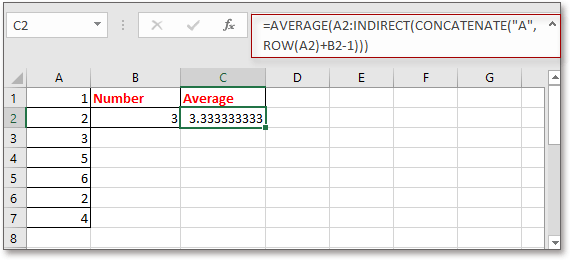Excel에서 다른 셀 값에 따라 범위를 정의하는 방법은 무엇입니까?
값의 범위를 계산하는 것은 대부분의 Excel 사용자에게 쉬운 일이지만, 특정 셀의 숫자에 따라 값을 계산해 본 적이 있습니까? 예를 들어, A 열에 값의 열이 있고, B2의 값에 따라 A 열의 값을 계산하고 싶습니다. 즉, B2가 4라면, 아래 스크린샷과 같이 A 열의 처음 4개 값을 평균 내고자 합니다. 이제 Excel에서 다른 셀 값에 따라 범위를 빠르게 정의하기 위한 간단한 수식을 소개합니다.
 셀 값에 기반하여 범위 정의
셀 값에 기반하여 범위 정의
다른 셀 값에 따라 범위에 대한 계산을 수행하려면 간단한 수식을 사용할 수 있습니다.
결과를 출력할 빈 셀을 선택하고 이 수식을 입력하세요 =AVERAGE(A1:INDIRECT(CONCATENATE("A",B2)))그리고 Enter 키를 눌러 결과를 얻으세요.
1. 수식에서 A1은 계산하려는 열의 첫 번째 셀이며, A는 계산 대상인 열이고, B2는 기준으로 삼는 셀입니다. 필요에 따라 이러한 참조를 변경할 수 있습니다.
2. 합계를 구하려면 다음 수식을 사용할 수 있습니다. =SUM(A1:INDIRECT(CONCATENATE("A",B2))).
3. 정의하려는 첫 번째 데이터가 Excel의 첫 번째 행에 있지 않고, 예를 들어 A2 셀에 있다면 다음과 같은 수식을 사용할 수 있습니다. =AVERAGE(A2:INDIRECT(CONCATENATE("A",ROW(A2)+B2-1))).
Excel에서 배경 또는 서식 색상별로 셀을 빠르게 계산/합계하기 |
일부 경우, 여러 가지 색상으로 구성된 셀 범위를 가지고 있을 수 있으며, 같은 색상에 따라 값을 계산하거나 합산하려고 할 때 어떻게 빠르게 계산할 수 있을까요? 이러한 작업은 Kutools for Excel의Count by Color기능을 통해 색상별로 다양한 계산을 빠르게 수행할 수 있으며, 계산 결과에 대한 보고서도 생성할 수 있습니다. 지금 바로 Kutools를 다운로드하여 사용해보세요! |
Kutools for Excel - 필수적인 300개 이상의 도구로 Excel을 강화하세요. 영구적으로 무료인 AI 기능을 활용하세요! 지금 바로 구매하기 |
최고의 오피스 생산성 도구
| 🤖 | Kutools AI 도우미: 데이터 분석에 혁신을 가져옵니다. 방법: 지능형 실행 | 코드 생성 | 사용자 정의 수식 생성 | 데이터 분석 및 차트 생성 | Kutools Functions 호출… |
| 인기 기능: 중복 찾기, 강조 또는 중복 표시 | 빈 행 삭제 | 데이터 손실 없이 열 또는 셀 병합 | 반올림(수식 없이) ... | |
| 슈퍼 LOOKUP: 다중 조건 VLOOKUP | 다중 값 VLOOKUP | 다중 시트 조회 | 퍼지 매치 .... | |
| 고급 드롭다운 목록: 드롭다운 목록 빠르게 생성 | 종속 드롭다운 목록 | 다중 선택 드롭다운 목록 .... | |
| 열 관리자: 지정한 수의 열 추가 | 열 이동 | 숨겨진 열의 표시 상태 전환 | 범위 및 열 비교 ... | |
| 추천 기능: 그리드 포커스 | 디자인 보기 | 향상된 수식 표시줄 | 통합 문서 & 시트 관리자 | 자동 텍스트 라이브러리 | 날짜 선택기 | 데이터 병합 | 셀 암호화/해독 | 목록으로 이메일 보내기 | 슈퍼 필터 | 특수 필터(굵게/이탤릭/취소선 필터 등) ... | |
| 15대 주요 도구 세트: 12 가지 텍스트 도구(텍스트 추가, 특정 문자 삭제, ...) | 50+ 종류의 차트(간트 차트, ...) | 40+ 실용적 수식(생일을 기반으로 나이 계산, ...) | 19 가지 삽입 도구(QR 코드 삽입, 경로에서 그림 삽입, ...) | 12 가지 변환 도구(단어로 변환하기, 통화 변환, ...) | 7 가지 병합 & 분할 도구(고급 행 병합, 셀 분할, ...) | ... 등 다양 |
Kutools for Excel과 함께 엑셀 능력을 한 단계 끌어 올리고, 이전에 없던 효율성을 경험하세요. Kutools for Excel은300개 이상의 고급 기능으로 생산성을 높이고 저장 시간을 단축합니다. 가장 필요한 기능을 바로 확인하려면 여기를 클릭하세요...
Office Tab은 Office에 탭 인터페이스를 제공하여 작업을 더욱 간편하게 만듭니다
- Word, Excel, PowerPoint에서 탭 편집 및 읽기를 활성화합니다.
- 새 창 대신 같은 창의 새로운 탭에서 여러 파일을 열고 생성할 수 있습니다.
- 생산성이50% 증가하며, 매일 수백 번의 마우스 클릭을 줄여줍니다!
모든 Kutools 추가 기능. 한 번에 설치
Kutools for Office 제품군은 Excel, Word, Outlook, PowerPoint용 추가 기능과 Office Tab Pro를 한 번에 제공하여 Office 앱을 활용하는 팀에 최적입니다.
- 올인원 제품군 — Excel, Word, Outlook, PowerPoint 추가 기능 + Office Tab Pro
- 설치 한 번, 라이선스 한 번 — 몇 분 만에 손쉽게 설정(MSI 지원)
- 함께 사용할 때 더욱 효율적 — Office 앱 간 생산성 향상
- 30일 모든 기능 사용 가능 — 회원가입/카드 불필요
- 최고의 가성비 — 개별 추가 기능 구매 대비 절약